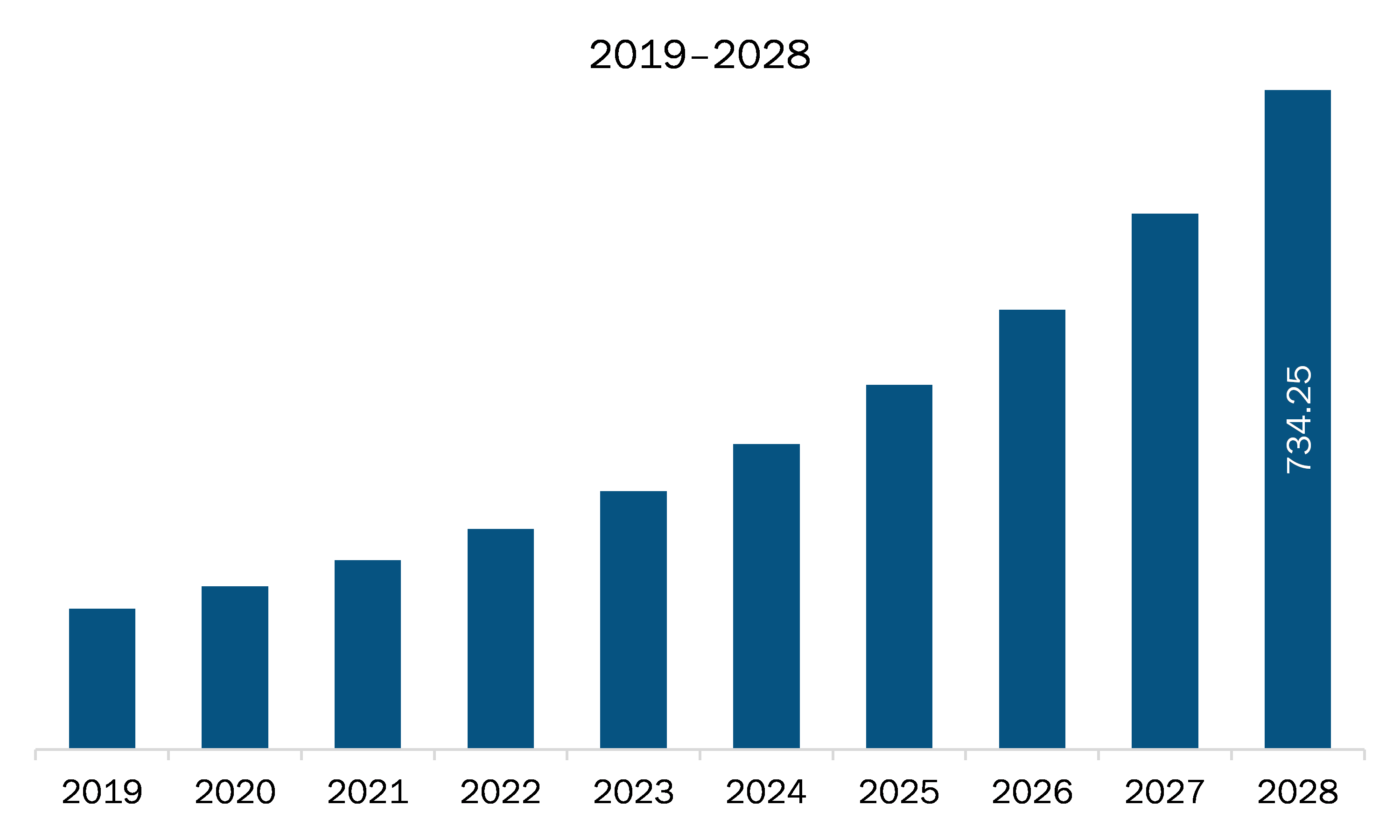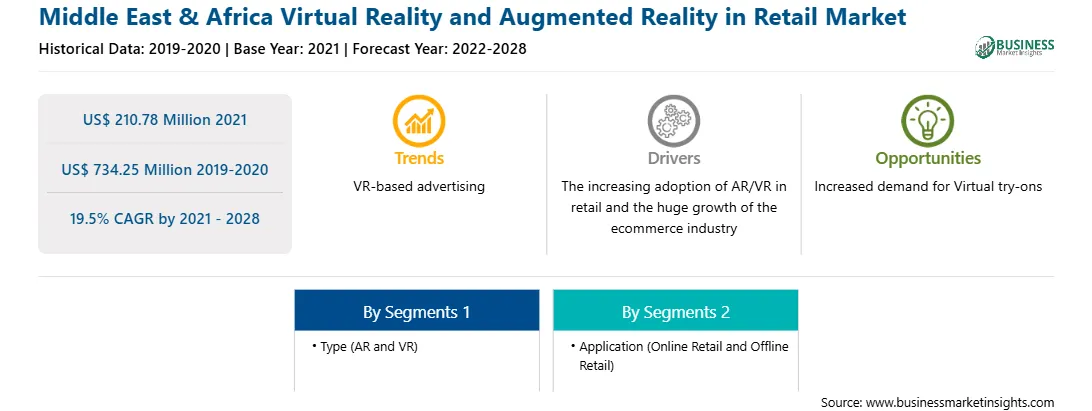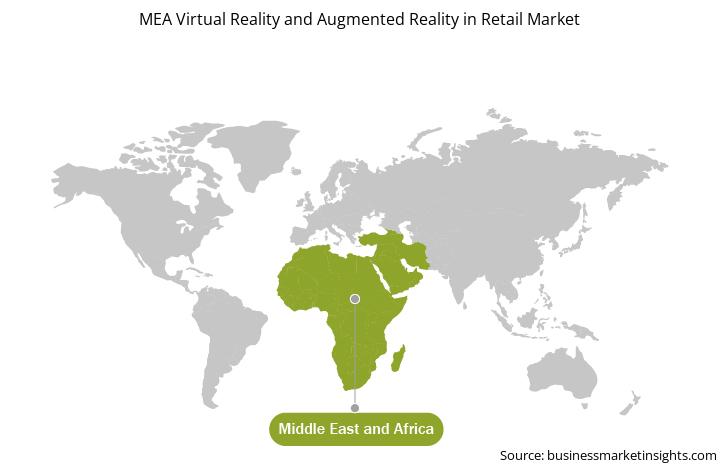Middle East & Africa Virtual Reality and Augmented Reality in Retail Market
No. of Pages: 86 | Report Code: TIPRE00024740 | Category: Electronics and Semiconductor
No. of Pages: 86 | Report Code: TIPRE00024740 | Category: Electronics and Semiconductor
Geographically, the MEA virtual reality and augmented reality in retail market is segmented into South Africa, Saudi Arabia, the UAE, and the Rest of the MEA. The UAE is the most advanced country in this area, and its government is focusing on taking advantage of a range of technologically advanced solutions to boost the overall retail infrastructure of the country. The infrastructure development in the Gulf countries is immense and the growth trend of commercial infrastructures continues to climb exponentially year-on-year. As these countries focus extensively on tourism, the commercial infrastructure plays a major role in respective country’s economy. High investment on commercial constructions such as supermarkets, specialty stores, and malls, is being witnessed in the region. Thus, the growth of commercial infrastructure is propelling the growth of retail outlets of major brands across the region. Also, high adoption across retail brands for implementing virtual fitting technology is the major factor driving the growth of the MEA virtual reality and augmented reality in retail market.
Saudi Arabia, the UAE, Egypt, Morocco, and Kuwait are the main countries facing the impact of COVID-19 in the Middle East & Africa. The retail industry across the Middle East & Africa region was severely impacted due to the outbreak of the pandemic in the starting of the year 2020. However, in order to combat the huge economic impact, countries like the UAE have taken necessary steps to continue economic activities across the region. The UAE government is thus promoting the adoption of advanced technology across the industries to increase efficiency among them. Global brands also made investments in technology to promote the retail business across the region. For instance, Ikea created virtual reality pop-up stores in Kuwait, Jordan, and Morocco to provide an immersive shopping experience for clients who are unable to visit physical Ikea stores. Since the launch of the same, the brand has experienced a rise in footfall by 19%. Thus, the high investment on technology across the region during the pandemic has positively impacted the growth of the market.

Strategic insights for the Middle East & Africa Virtual Reality and Augmented Reality in Retail provides data-driven analysis of the industry landscape, including current trends, key players, and regional nuances. These insights offer actionable recommendations, enabling readers to differentiate themselves from competitors by identifying untapped segments or developing unique value propositions. Leveraging data analytics, these insights help industry players anticipate the market shifts, whether investors, manufacturers, or other stakeholders. A future-oriented perspective is essential, helping stakeholders anticipate market shifts and position themselves for long-term success in this dynamic region. Ultimately, effective strategic insights empower readers to make informed decisions that drive profitability and achieve their business objectives within the market.

| Report Attribute | Details |
|---|---|
| Market size in 2021 | US$ 210.78 Million |
| Market Size by 2028 | US$ 734.25 Million |
| Global CAGR (2021 - 2028) | 19.5% |
| Historical Data | 2019-2020 |
| Forecast period | 2022-2028 |
| Segments Covered |
By Type
|
| Regions and Countries Covered | Middle East and Africa
|
| Market leaders and key company profiles |
The geographic scope of the Middle East & Africa Virtual Reality and Augmented Reality in Retail refers to the specific areas in which a business operates and competes. Understanding local distinctions, such as diverse consumer preferences (e.g., demand for specific plug types or battery backup durations), varying economic conditions, and regulatory environments, is crucial for tailoring strategies to specific markets. Businesses can expand their reach by identifying underserved areas or adapting their offerings to meet local demands. A clear market focus allows for more effective resource allocation, targeted marketing campaigns, and better positioning against local competitors, ultimately driving growth in those targeted areas.

The virtual reality and augmented reality in retail market in MEA is expected to grow from US$ 210.78 million in 2021 to US$ 734.25 million by 2028; it is estimated to grow at a CAGR of 19.5% from 2021 to 2028. Brands use virtual and augmented reality technology to promote themselves and their products in virtual reality marketing. The technology generates a fictitious yet realistic setting. Depending on the device, virtual reality marketing might be visual or multi-sensory. A full virtual reality headset provides a fully immersive experience, whereas a virtual reality Instagram filter only overlays objects or photographs onto the camera view. Augmented reality (AR) marketing is what these filters are. AR is a type of virtual reality in which a virtual image is superimposed on the real environment.
The MEA virtual reality and augmented reality in retail market is segmented into type, application, and country. In terms of type, the virtual reality and augmented reality in retail market is bifurcated into augmented reality and virtual reality. The AR segment dominated the market in the year 2020 and is expected to be the fastest growing during forecast period. Based on application, the virtual reality and augmented reality in retail market is categorized into online retail and offline retail. The online retail segment dominated the market in the year 2020 and is expected to be the fastest growing during forecast period.
A few major primary and secondary sources referred to for preparing this report on the virtual reality and augmented reality in retail market in MEA are company websites, annual reports, financial reports, national government documents, and statistical database, among others. Major companies listed in the report are Epson America, Inc.; Google LLC; Infosys Ltd.; Intel Corporation; Microsoft Corporation; and PTC Inc. among others.
The Middle East & Africa Virtual Reality and Augmented Reality in Retail Market is valued at US$ 210.78 Million in 2021, it is projected to reach US$ 734.25 Million by 2028.
As per our report Middle East & Africa Virtual Reality and Augmented Reality in Retail Market, the market size is valued at US$ 210.78 Million in 2021, projecting it to reach US$ 734.25 Million by 2028. This translates to a CAGR of approximately 19.5% during the forecast period.
The Middle East & Africa Virtual Reality and Augmented Reality in Retail Market report typically cover these key segments-
The historic period, base year, and forecast period can vary slightly depending on the specific market research report. However, for the Middle East & Africa Virtual Reality and Augmented Reality in Retail Market report:
The Middle East & Africa Virtual Reality and Augmented Reality in Retail Market is populated by several key players, each contributing to its growth and innovation. Some of the major players include:
The Middle East & Africa Virtual Reality and Augmented Reality in Retail Market report is valuable for diverse stakeholders, including:
Essentially, anyone involved in or considering involvement in the Middle East & Africa Virtual Reality and Augmented Reality in Retail Market value chain can benefit from the information contained in a comprehensive market report.